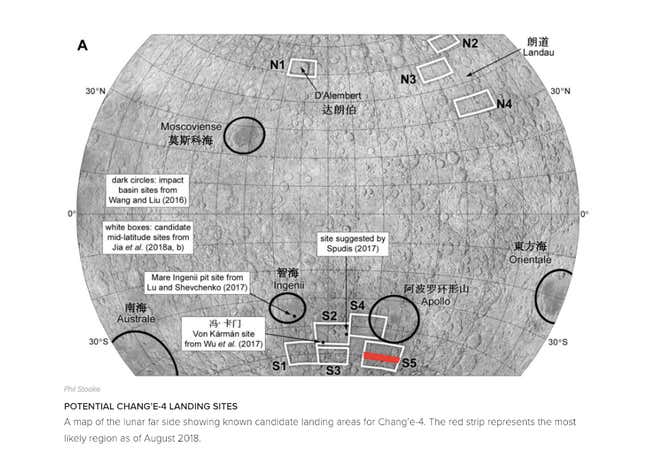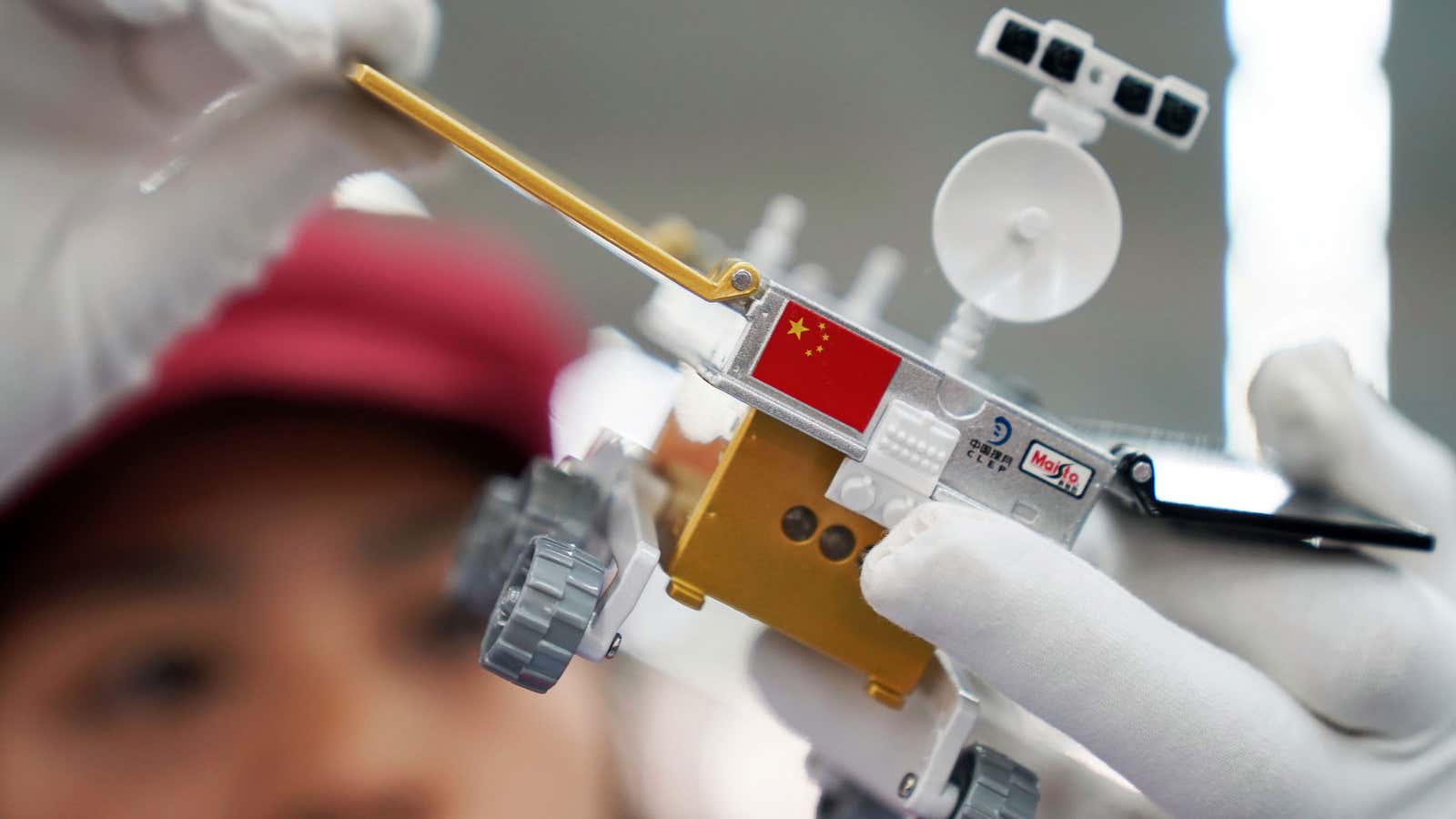A little more than a decade ago, China began its lunar exploration by sending a spacecraft named after an ancient lunar goddess to the Moon. Thanks to the Chang’e-1 spacecraft, China became the world’s third country to have its own Moon maps, after the former Soviet Union and the US.
This week, China’s latest Moon exploration mission is expected to make history for human space exploration—by landing a spacecraft on the far side of the Moon for the first time ever. China’s Chang’e-4 lander and rover took off early on Dec. 8 local time, and is expected to touch down any day now.
On Sunday (Dec. 30), China’s space agency had said the rover was in position for landing, in an orbit bringing it just 15 kilometers (9 miles) away from the lunar surface at the closest point, but didn’t specify exactly when the landing would happen. China space program trackers expect it to take place Thursday morning (Jan. 3).
If it’s successful, it’ll be a significant achievement for China’s space program, given the technical complexity involved, from the landing itself, to maintaining communication with the spacecraft.
“This [would be] the first time that the Chinese space program has done something that no other country has done before,” said Brian Harvey, author of China In Space, a 2013 history of China’s space program.”Up to now, China has largely matched US and USSR achievements—not for the sake of doing so—but because they are necessary steps in building a space program. This is quite new.”
For science, the mission could finally bring the secrets of the moon’s hidden side out of the shadow. Here’s what we know about the challenges of pulling off a far-side landing.
A landing spot named for a “Martian”
In 2016, a research paper from a research institute under China’s National Space Administration looked at five possible landing sites, wrote Philp Stooke, an associate physics and astronomy professor at Canada’s Western University who studies planetary mapping. These sites included the impact areas named Orientale, Australe, Moscovinse, Apollo, and Ingenii. These were ruled out because their latitudes meant they would either get too hot or too cold for the spacecraft, Stooke explained in an email to Quartz.
By 2017, according to Stooke, a slide presented by Chinese scientists at Germany’s space center showed the landing site would likely be the relatively smooth Von Kármán crater, a 186-kilometer-wide (110 miles) region named after Theodore Von Kármán, a Hungarian-American aerodynamics expert who helped found NASA’s Jet Propulsion Laboratory, and was its first director. Von Kármán is one of the five scientists known as “the Martians” for their significant scientific contributions in the 20th century.
The Von Kármán region is itself located in an even larger impact crater called the South Pole-Aitken (SPA) basin that is 2,500 kilometers wide—it’s so huge that the impact that likely excavated parts of the Moon’s mantle. The basin is believed to have formed from an impact some 4 billion years ago, according to Zou Yongliao (link in Chinese), director of lunar and space exploration department of Chinese Academy of Sciences. Dating the basin (pdf) is an important lunar science goal that could help capture whether the Moon faced a cataclysmic event, and perhaps provide some clues about what was occurring in the solar system at that time.

Waiting for the light
Chang’e-4 entered its planned orbit for landing on Sunday (Dec. 30) according to China Academy of Space Technology (CAST) (link in Chinese), the state-owned manufacturer of the spacecraft. It has also done several successful “phone calls” with the Queqiao relay satellite, suggesting there’s good signal connection, according to the CAST (link in Chinese). Queqiao was launched in June to be a bridge between the spacecraft and the earth, since direct communication between the two isn’t possible—the relay satellite has an irregular circular orbit that keeps the Earth and far side in view at the same time.
Chang’e-4 is waiting for the perfect timing to land—there needs to be sunlight in the landing region since it’s solar-powered—and it also needs precise communication with the relay satellite as it navigates the rugged far side.
When Chang’e-4 made its first braking maneuver near the Moon on Dec. 9 (link in Chinese) to enter the lunar orbit, it happened to be night in the landing region. So it had to remain in lunar orbit over the targeted landing site and wait for sunlight to return to the far side, according to Sun Zezhou (link in Chinese), chief designer of Chang’e-4 at CAST.
That window is coming around Jan. 3 Beijing time, after 26 days (link in Chinese) of travel, according to CAST.
Chang’e-4 needs to go through several steps before touchdown, beginning around 15 kilometers (9 miles) above ground. It’ll adjust speed when it’s 8 km above, and adjust its position when it’s 6 km above, hovering for a while at the height of 100 meters, and using its hazard-avoidance instrument to calibrate its final landing spot in the last 30 meters, according to a demonstration from CAST.
The chance of a safe landing is just 50-50, China in Space author Harvey told Quartz, with risks at multiple points, from speed control to communications with the relay satellite to issues with the rover’s radar soundings and hazard -avoidance skills. China has practiced landing, radar, and hazard-avoidance tests in the western Xinjiang desert, which was selected as the best available analogue to the Moon, according to Harvey’s research.
“The scientists and engineers studied the area planned for the landing exhaustively to find a flat area with as few rocks, craters or slopes as possible. The map of the intended landing spot was then programmed into the CE-4 [Chang’e-4] computer so that when it arrives there, the radar soundings will be matched against the map and the guidance system will then bring it into the right spot,” Harvey told Quartz. “The Americans use a similar system for their Mars landings. It may sound simple in theory, but it is being done a long distance away without the possibility of human intervention.”
Farming on the moon, listening to the universe
Just like geologists on earth, scientists can better understand our satellite by studying its mantle, the layer between the core and the crust, to understand how it came into being, and what chemical elements helped form it. Humans have so far brought back some 382 kilograms of objects, including lunar rocks and core samples during the six explorations of the Moon from the Apollo missions carried out by the US between 1969 and 1972. But none of those came from the far side.
The far side has fewer “mare”—dark-colored portions that ancient astronomers took to be seas—and greater visible crater coverage than the near side. Scientists have yet to understand what led to the differences but Chang’e-4 might help change that.
The mission is carrying instruments developed by scientists in Germany, Netherlands, and Sweden to study the moon and the universe if the lander is able to land successfully.
German scientists at the University of Kiel helped develop the Lunar Lander Neutrons and Dosimetry, which is traveling on the lander and will measure lunar radiation levels, among other experiments. Swedish scientists from Institute of Space Physics and the National Space Science Center have designed an Advanced Small Analyser for Neutrals, which is traveling on the rover and will investigate how solar wind interacts with the lunar surface. On the Queqiao relay satellite, a radio antenna designed by researchers from Netherland’s Radboud University will pick up signals that can reveal the origins of the universe.
China scientists have also put seeds of potatoes and arabidopsis—a small flowering plant belonging to the mustard family—along with silkworm cocoons on the spacecraft, to test life sustainability on the Moon.
If China is successful, it will boost its confidence in the Chang’e-5 mission, slated for late 2019, Harvey said. China will use Chang’e-5 to collect and bring back samples on the Moon’s near side.
The ultimate goal for China, according to officials, is to put humans on the Moon—a milestone already achieved more than half a century ago by the US. China could achieve that in 2030, said Harvey, adding that “whereas Apollo made expeditions of one to three days, ‘flags and footprints,’ the first Chinese landing will be for a month and a base will be built not long afterward.”
Looking for more in-depth coverage? Sign up to become a member and read more in-depth coverage of the history of moon exploration.
